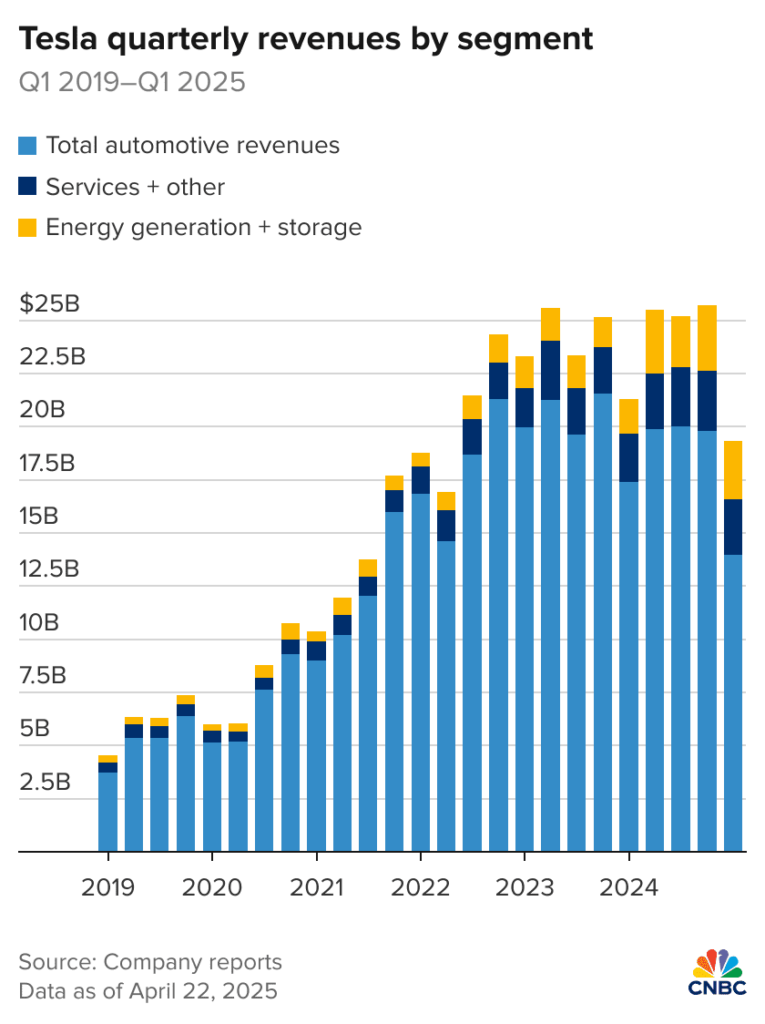Elon Musk is back in the headlines as he shifts focus from his involvement in DOGE to give more attention to Tesla after a significant hit to the company’s profits. In Q1 2025, Tesla’s earnings plummeted by 70%, reporting a massive 71% drop in net income. Considering these financial challenges, Musk plans to dedicate more time and energy to Tesla’s core business. Tesla’s Q1 results show that while the company is still profitable, it is grappling with issues such as stagnant growth and fewer vehicle deliveries. Here’s a breakdown of Musk’s strategy and what it means for the company and its future.
What’s Happening & Why This Matters
Tesla, the electric vehicle maker Musk has led since its inception, has seen better days. The company’s profits steeply declined in Q1 2025, with net income plummeting 71%. Despite the company’s ability to maintain profitability, it has seen a decrease in vehicle deliveries, down to 336,681 units from 495,570 units in Q4 2024. While zero-emission tax credits propped up some of Tesla’s profits, these sales were not enough to offset the company’s stagnant growth. This shift in Tesla’s financial performance is a big deal, as the company had previously enjoyed rapid expansion and market dominance. The significant drop in sales raises concerns about Tesla’s ability to maintain its position in the competitive EV space.
A Decision to Focus on Tesla
In light of the pressure from Tesla’s financial challenges, Musk has decided to reduce his involvement with DOGE, a government efficiency initiative he took on in early 2025. According to Musk, stepping back from DOGE will allow him to focus on Tesla’s future, including plans to ramp up production and address the rising competition in the EV industry. By focusing on Tesla’s strategic growth and core business, Musk aims to ensure that the company continues to produce cutting-edge vehicles and autonomous technology.
The reduction in Musk’s involvement with DOGE is a strategic move to prioritize Tesla’s ongoing challenges, particularly the production of affordable EVs. Tesla plans to unveil new affordable vehicles as soon as mid-2025. These cars could be priced as low as $30,000, aiming to cater to a broader customer base. This shift comes as more automakers ramp up their electric vehicle production, further intensifying competition in the EV market.

Robotaxi Project: Paving the Way for Autonomous Vehicles
One of the key features of Tesla’s future vision is its robotaxi project. With autonomous vehicle technology still in development, Tesla has announced plans to test robotaxis in Austin, Texas, by June 2025. The company plans to extend this service to more U.S. cities by the end of the year. If successful, Tesla’s robotaxi service could revolutionize people’s travel, providing a more sustainable and autonomous transportation option. Musk’s shift in focus to Tesla will likely involve accelerating the rollout of this service, which he believes could dramatically change urban transportation.
A Strategic Focus on Tesla
Musk’s increased attention on Tesla may have long-term implications for the company’s growth. The affordable EV model and advancements in robotaxi technology could help Tesla reassert its leadership in the EV market. Tesla’s future success will depend not only on its ability to produce affordable electric vehicles but also on its ability to stay ahead of the competition in autonomous driving technology. With Musk dedicating more time to the company, it’s clear that Tesla’s next steps are crucial to securing its place as the leading force in the future of transportation.
TF Summary: What’s Next
Musk’s decision to focus more on Tesla is pivotal in the company’s history. With a major profit dip, the company must adapt quickly to maintain its dominance in the EV space. The focus on affordable EVs and the development of robotaxi technology are two crucial strategies that could define Tesla’s future. However, these initiatives face challenges, from regulatory hurdles to production timelines. As Tesla grapples with competition and financial pressure, Musk’s leadership will be key in determining whether the company can bounce back and stay ahead in the electric vehicle and autonomous driving sectors.
— Text-to-Speech (TTS) provided by gspeech


